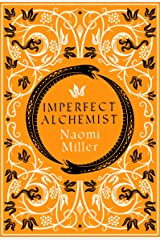Imperfect Alchemist: Writing Women’s Voices
By Naomi Miller
 Many popular novels about Renaissance women picture them in relation to powerful men. One need look no further than the steady stream of novels about the wives of Henry VIII, perpetuating a phenomenon that I have named the “Noah’s ark approach,” which positions women in dependent relation to famous men. Contemporary readers of historical fiction have missed out on an extraordinary array of women’s voices that were heard in their own period – both acclaimed and reviled – but then silenced over time and excluded from the canon of accepted classics.
Many popular novels about Renaissance women picture them in relation to powerful men. One need look no further than the steady stream of novels about the wives of Henry VIII, perpetuating a phenomenon that I have named the “Noah’s ark approach,” which positions women in dependent relation to famous men. Contemporary readers of historical fiction have missed out on an extraordinary array of women’s voices that were heard in their own period – both acclaimed and reviled – but then silenced over time and excluded from the canon of accepted classics.
My own projected series, Shakespeare’s Sisters, comprises six interrelated historical novels that imagine the stories of early modern women authors from their own perspectives. These novels offer fictional engagements with an array of early modern figures, from queens to commoners. Historical women, including Mary Sidney Herbert, the protagonist of Imperfect Alchemist, are at the center of the narratives, bringing their voices and experiences to life for modern audiences.
Shakespeare’s Sisters centers on women whose lives and voices both shape and are shaped by women, many of whom appear in each other’s stories. Spanning generations and social classes, the series paints a multi-hued portrait of Renaissance England, seen through the lives of courtiers, commoners, poets, playwrights and, above all, indomitable women who broke the rules of their time while juggling many of the responsibilities and obstacles faced by women worldwide today.
Imperfect Alchemist, the opening novel in the series, is an imaginative reinvention of the remarkable life of Mary Sidney Herbert, Countess of Pembroke – friend of Queen Elizabeth, visionary scientist, advocate for women writers and scandalous lover of a much younger man. One of the earliest women authors in Renaissance England to publish under her own name, the Countess successfully forged a place for herself in a man’s world.
A member of one of England’s leading families, she carved out space for herself as a daring and often controversial figure in a royal court riven by jealousies and intrigues. Her pioneering literary and scientific experiments challenged many of Renaissance England’s established conventions – one of the things that most strongly drew me to her.
As an influential literary patron as well as author, she convened a literary salon of writers whose membership included Edmund Spenser, John Donne, Ben Jonson and other authors interested in testing the limits of literary forms. Her own play about Antony and Cleopatra is believed to have influenced Shakespeare.
Responding to the Countess’s role as mentor to a cohort of women writers – including Mary Wroth, Aemilia Lanyer, Elizabeth Cary and Anne Clifford, all of whom will play lead roles in the Shakespeare’s Sisters series – I have imagined these women into her circle, their interaction with the male authors inspiring visions of new possibilities.
In Imperfect Alchemist, the fictional Mary Sidney Herbert is mediated through my knowledge of her real-life circumstances and her writings. She was also a scientist, practicing alchemy in her private laboratory to prepare chemical and herbal remedies. Although the Countess was a well-regarded alchemist, no manuscript records of her alchemical recipes or experiments survive. I have drawn on historical accounts documenting the detailed practices of other female alchemists of the period present an authentic, if conjectural, account of her scientific work.
As the acclaimed historical novelist Sarah Dunant observes, fashioning historical verisimilitude, “like a pointillist painting,” lies in the details. Indeed, Dunant describes historical details as “gold dust,” giving her readers confidence that they’re encountering worlds that actually existed, thus grounding the novel’s inventions in a “multicolored” world.
To lend a broader perspective than Mary’s point of view alone, I introduce an invented character, Rose Commin, her lady’s maid – a country girl who brings an entirely different outlook to their intersecting lives. Trained to serve and observe, Rose proves to be both a keen judge of character and a skilled artist whose drawings give new dimension to Mary’s own life and writings.
Most of the characters in the book are fictional renditions of real historical figures whose roles combine elements of their actual lives with my own inventions. The “supporting cast,” both real and invented, adds three-dimensionality to the fictional storyline.
Once I embarked on the first draft of the novel, I had to guard against my tendency, as a scholar, to plunge down historical or literary “rabbit-holes,” enticed by fascinating details that would interrupt the writing process and might obscure rather than illuminate the story – dust rather than gold dust. The most valuable advice I received came from a novelist friend who reminded me that “as a novelist, your responsibility is to the story, not to history. Just tell the story that matters!”
So what is the story that matters in Imperfect Alchemist? Most of the novel is written from two alternating points of view: Mary’s, in the third person, and Rose’s, in the first person. As I was writing, the story that came to matter the most was about both of these women, driven by sometimes conflicting imperatives of creative expression and desire – one a quiet artist, the other an outspoken author – who come to connect across class lines, learning truths from each other that they never expected to discover about themselves and their world.
The celebrated novelist Hilary Mantel maintains that “you become a novelist so you can tell the truth,” and observes that “most historical fiction is … in dialogue with the past.” My driving aim is to “tell the truth” that becomes visible in these historical women’s writings, and to put my own fiction into dialogue with theirs.
My goal has been to tell a story that imagines the perspectives of historical women in a world that encompasses both known facts and imagined possibilities, illuminating the historical record without being limited by it. I like to think that the real Mary Sidney Herbert, alchemist and author, would appreciate my transmutation of her story.
—
Naomi Miller is a professor of English and the Study of Women and Gender at Smith College. An award-winning author of books on Renaissance women and gender, she teaches courses on Shakespeare and his female contemporaries, as well as on modern women’s adaptations and reinventions of Shakespeare. Her debut novel, Imperfect Alchemist (Allison & Busby, November 2020), focuses on Mary Sidney Herbert, Countess of Pembroke.
Find out more about Naomi on her website https://naomimillerbooks.com/
Follow her on Twitter https://twitter.com/NaomiMillerBks
IMPERFECT ALCHEMIST
 In Tudor England, two women dare to be different …
In Tudor England, two women dare to be different …
Two women. One bond that will unite them across years and social divides.
England, 1575. Mary Sidney, who will go on to claim a spot at the heart of Elizabethan court life and culture, is a fourteen-year-old navigating grief and her first awareness of love and desire. Her sharp mind is less interested in the dynastic alliances and marriages that concern her father, but will she be able to forge a place for herself and her writing in the years to come?
Rose Commin, a young country girl with a surprising talent for drawing, is desperate to shrug off the slurs of witchcraft which have tarnished life at home. The opportunity to work at Wilton House, the Earl of Pembroke’s Wiltshire residence, is her chance.
Defying the conventions of their time, these two women, mistress and maid, will find themselves facing the triumphs, revelations and dangers that lie ahead together.
BUY HERE
Category: Contemporary Women Writers, On Writing

























